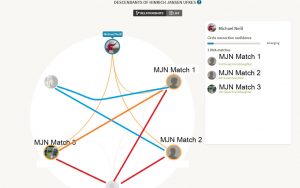 Analyzing DNA matches is part science and part art. It also takes some practice. While working with the results of a new DNA test, I’m “grossly” sorting the matches into three categories based upon the known heritage of the testee with a Chicago-born mother and a Missouri-born father. The Chicago-born mother had a father of unknown origins (due to adoption) and a mother who was native of upstate New York who came Chicago around 1900 with her father. The Chicago-born mother met her Missouri-born husband when he came to Chicago in the 1930s looking for work. Based upon the paper pedigree, I’m sorting the matches as follows:
Analyzing DNA matches is part science and part art. It also takes some practice. While working with the results of a new DNA test, I’m “grossly” sorting the matches into three categories based upon the known heritage of the testee with a Chicago-born mother and a Missouri-born father. The Chicago-born mother had a father of unknown origins (due to adoption) and a mother who was native of upstate New York who came Chicago around 1900 with her father. The Chicago-born mother met her Missouri-born husband when he came to Chicago in the 1930s looking for work. Based upon the paper pedigree, I’m sorting the matches as follows:
- French-Canadian–for the maternal grandmother. I’m not separating these out by specific families yet because there’s too much intermarriage and working on these families is not my immediate goal. Looking at the matches for this submission so far has indicated that (in this case) if they match one French-Canadian line, they match only other French-Canadian lines. These matches are being put into two categories–French-Canadians whose tree has a match and a connection I can figure out easily and those French-Canadians whose tree match I can’t find.
- Southern–for the maternal grandfather. The maternal grandfather’s parents and grandparents are known. If the person has a tree and I can quickly determine the relationship, I note it and put it in the group for the correct family. If a treeless match is shared with one of these matches, I place it in the “Southern” category for later sorting and analysis. These families are not as inter-married as the French-Canadians, but they tend to follow the same general migration pattern with origins in Kentucky, Tennessee, Virginia, and the Carolinas. At this point these families are not my focus. My operating procedure is to figure out quickly the ones that I can easily to facilitate sorting of matches with no trees, unresponsive submitters, etc.
- Other–for the maternal grandfather, a man whose heritage is completely unknown, but was born in the Chicago, Illinois, area in the 1880s. This is the man for whom I’m really looking. In my “initial sort,” I’m not trying to determine any specific relationships as I don’t have any real paper trail on which to hinge my matches.
The sorting is based upon my goal (learning more about the mysterious grandfather) and what I do know about the heritage of the testee. That approach varies from one testee to another.
Match sorting is discussed in more detail in my AncestryDNA webinars.

One response
Just in case you haven’t seen this…..go to Ancestry.com, click on Extras and look for webinars on DNA Circles. The guy that does this is awesome and can help explain why and how this is done…great resource. cc:)